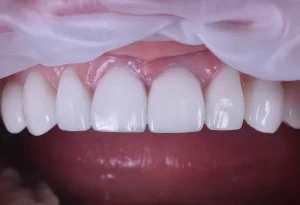
Importance of oral hygiene and how many times to brush your teeth.
The oral cavity is an ideal environment for the reproduction of microorganisms. The temperature is around 37° C, which is perfect for their development. Additionally, it has high humidity, a source of food (remains of food and drinks), and no sunlight (ultraviolet kills harmful bacteria). These conditions lead to the active life of pathogens. While some bacteria are beneficial or conditionally pathogenic, many can cause oral diseases such as stomatitis or cavities. Proper oral hygiene can remove a significant portion of these bacteria and minimize their harmful effect. Neglecting oral hygiene can lead to an imbalance of the acidic environment, slowing the production of saliva overnight, which intensifies bacterial growth.
Moreover, everyday drinks such as tea and coffee can have an adverse effect on tooth enamel, causing it to turn yellow. Therefore, it’s crucial to perform oral hygiene correctly, as poorly done cleaning may not be helpful and may even cause harm.
The Frequency of Brushing
Many people wonder how often they should brush their teeth. Some assume that the more often they do it, the better, thinking that they can remove the maximum amount of pathogens. However, this belief is incorrect. Dental professionals recommend brushing twice a day: in the morning after waking up and before going to bed. Exceptions are made for those who wear orthodontic appliances and prostheses, who are at a higher risk of dental complications. It’s recommended that they brush their teeth as often as possible after every meal. If this isn’t possible, rinsing the mouth with mouthwash or water, using dental floss, or chewing gum can be helpful.
When and Why to Avoid Brushing
It’s not recommended to brush your teeth immediately after consuming highly acidic foods such as citrus fruits, fresh juice, and soda, as they can affect the enamel’s surface. Waiting for at least 30 minutes after then proceeds with oral hygiene is ideal. Otherwise, doing so can lead to microscopic defects, which cause further damage to the coronal part. It’s also not advisable to brush teeth before drinking coffee or tea, as the enamel is more susceptible to pigments, even when using the best whitening toothpaste. Experts advise brushing for at least three minutes, devoting forty-five seconds to each jaw. Brushing too long or too quickly can also lead to dental problems.
The Right Brushing Techniques
To perform oral hygiene correctly, follow these steps: Rinse the brush before using it. Apply a sufficient amount of toothpaste to the brush (about 1 cm). Brush the bottom teeth, then the top ones, at a 45-degree angle. Use a sweeping motion to clean the sides of your teeth facing your cheeks. For front teeth, use circular and side-to-side motions. Brush each area for at least 20 strokes before proceeding to the next. Clean your tongue with the opposite side of the brush head or a specialized tongue cleaner. Massage your gums gently. Rinse your mouth with water or mouthwash, and use dental floss to clean tight spaces between your teeth.
Finally, a toothbrush should be replaced every three months or so, regardless of its apparent cleanliness. Bacteria can accumulate between bristles, leading to potential oral health issues.
